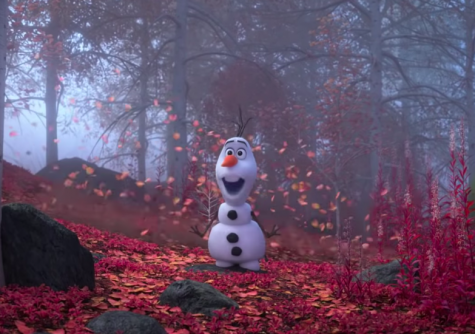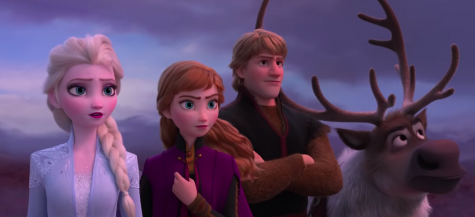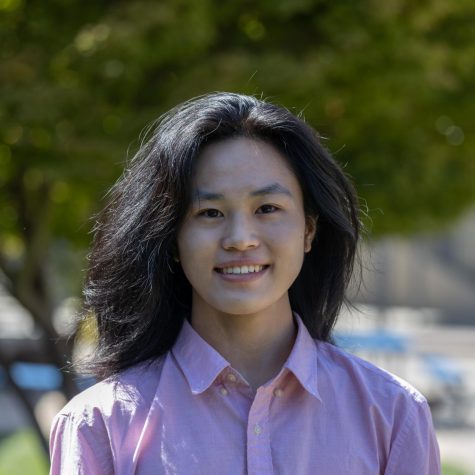“Frozen II”: It’s got plenty of ice but no dice
December 17, 2019
“Frozen”: You either love it or you hate it, but it’s impossible not to have an opinion about it. In 2013, “Frozen” fever swept the globe, immortalizing the movie as a cultural phenomenon. After six years, “Frozen II” has finally arrived, catering to all ages, whether it be the elementary-school target audience, the teenagers reminiscing about their youth or the parents being dragged along. While “Frozen II” was a wild success at the box office, the reality is it falls just short of its iconic predecessor.

Set three years later, the movie starts off with Elsa hearing a mysterious siren calling to her, which prompts her to inadvertently awaken the dormant nature spirits. The awakened spirits are bitter because of fighting between Arendelle and the indigenous Northaldra people. They set their sights on Arendelle, forcing Anna and Elsa to confront their family’s complicated past in order to right a wrong and find out the origin of Elsa’s powers.
While the overall premise of finding out more about Elsa’s powers was an interesting one, the labyrinthine plot left more to be desired. The plot was convoluted and chock-full of plot holes and unanswered questions. Moreover, because the plot relied so heavily on new information, there was prolonged exposition that could’ve had smoother transitions. Although these details were interesting, “Frozen II” failed to find a balance between backstory and plot, ultimately biting off more than it could chew.
Like any good kids movie, “Frozen II” was filled with uplifting messages, like the realization that sometimes making amends means making a personal sacrifice. In “Frozen II”, this comes in the form of Anna and Elsa atoning for how their family impacted the indigenous Northaldra people. It’s here some social commentary begins to pop up: The film draws a lot of parallels between Arendelle’s past actions with the Northuldra and the U.S. colonists’ actions with the Native Americans. Especially given the release date—around Thanksgiving—this connection seems to be a conscious decision on the director’s part. In the film, the solution comes at a cost to Elsa, Anna and Arendelle as a whole, suggesting the wrongs committed by the U.S. colonists in the real world may need to be remedied by straightforward action.
Following the path laid out for her in “Frozen,” Elsa continues her journey of self-discovery. As more details from her past are revealed, she finds herself questioning her place in the world. Her storyline seems to mimic her original one, and, as she does during “Let It Go,” Elsa once again sheds her cape, lets down her hair and prepares herself for a new stage in her life. At some points, though, it felt as though Elsa’s path was a bit too similar to her first storyline: the closure from the first movie is upended in the second just for her to find her place again.
Anna’s character also had many consistencies between “Frozen” and “Frozen II.” She’s still relentlessly optimistic, and most of her character development was in her relationships with others, namely with Elsa and Kristoff.
In “Frozen,” Anna spent most of the movie chasing after Elsa, but in “Frozen II,” now that Anna is reunited with Elsa, she spends the whole movie desperately trying to cling to her. Because of this, Elsa often feels smothered by Anna. While this conflict helped develop Anna and Elsa’s relationship, it’s resolved quickly without ever actually being addressed in any meaningful way.
Anna’s other main relationship with Kristoff takes a back seat in “Frozen II” but remains important nonetheless. Kristoff and Anna’s interactions are special because Disney avoided making Kristoff into a typical knight in shining armor. When Kristoff comes to Anna’s aid, he says, “I’m here, what do you need?” This one line sets Kristoff apart as one of the most progressive Disney love interests—rather than trying to shelter Anna and take over the situation, Kristoff recognizes that Anna can handle herself, and asks her how he can best help since she’s the one with the most knowledge of the situation. While these details might not seem like a big deal, Kristoff has proven himself to be the kind of love interest we ought to have in kid’s movies.
And, of course, Olaf comes back in “Frozen II” as the same bubbly character that he was in the first, but with a twist: he has a budding sense of maturity, yet still relatable and ridiculous. This common theme follows him through his solo, “When I am Older,” where he wonders if all of life’s questions will be answered with time. His snarky and comedically philosophical personality parallels that of “Frozens”’ target audience who have grown up in the past six years, making him all the more relatable. Funnier than ever, Olaf is clearly one of the best parts of the movie.

Anna, Elsa, Sven, Kristoff, and Olaf pause at the edge of the Enchanted Forest.
Following in the footsteps of “Frozens”’ iconic songs, “Frozen II” introduces a host of new tunes, although they fail to reach the high bars of “Let It Go” and “Do You Want to Build a Snowman.” The songs were hit-or-miss, often emotionally charged, but lacking catchiness. Moreover, the spacing between songs is awkward, with songs crammed too close together at the beginning, but too far apart at the end.
The main anthem of the movie, “Into the Unknown,” is similar to “Let It Go,” and plays as Elsa tries to discover who she is. Although the Panic! at the Disco rendition in the end credits undoubtedly slaps, Idina Menzel’s version that’s used in the movie is lukewarm, lacking the lustrous magic of the songs from the original movie. Similarly, Elsa’s climactic solo song, “Show Yourself,” and Kristoff’s 80’s music video-inspired “Lost in the Woods” are good, but forgettable. Anna’s solo number, “The Next Right Thing,” bears a poignant message of picking oneself up after hardship, but because of its somber tune, it isn’t really something that people will be blasting in their room. Likewise, the haunting lullaby “All is Found” provides a nice motif to link different parts of the storyline together, but is one that will likely never be played outside of the theater.
One of the places where “Frozen II” eclipsed “Frozen,” though, was in its animation. In the six-year gap between movies, Disney Animations developed and tested new animation software and techniques, and it paid off. In “Frozen II,” the animation is rendered with stunning detail from each strand on Elsa’s head to the three-dimensional jewels of her clothing to the stitches in cloth. Even more impressive, the tempestuous waves that repeat throughout the movie are made with immense realism, to the point where you almost forget it’s animated. The film goes a step further with a horse made out of water that is somehow able to express emotions and still seem like a horse. Paired with well-planned cinematography, these elements create truly magical scenes.
From an objective standpoint, “Frozen II” is a good movie. In comparison with the original, though, it loses some of its magic, but comparing any movie to “Frozen” is tough. Many of the aforementioned issues are ones younger audiences—the target audience of this children’s film—would not have had problems with. And even for people who did notice those issues, the movie was still heart-warming and enjoyable. Plus, you can never really get enough of Olaf.




